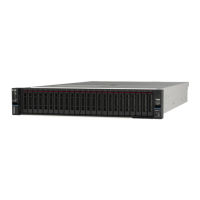General problem determination procedures
Use the information in this section to resolve problems if the event log does not contain specific errors or the
server is inoperative.
If you are not sure about the cause of a problem and the power supply is working correctly, complete the
following steps to try to resolve the problem:
1. Check in Setup Utility and make sure all the installed components are enabled.
2. Make sure the firmware of the installed components are the latest version.
3. Turn off the server.
4. Ensure that the server is cabled correctly.
5. Remove or disconnect the following devices if applicable, one at a time, until you find the failure. Turn on
and configure the server each time you remove or disconnect a device.
• Any external devices
• Surge-suppressor device (on the server)
• Printer, mouse, and non-Lenovo devices
• Each adapter
• Storage drives
• One memory module at a time until you reach the minimum configuration that is supported for the
server
Notes: The minimum configuration required for the server is as the following:
• One processor and one processor cooling heat sink
• One 16 GB ECC UDIMM in DIMM slot 1
• One power supply
• One power cord
• One 3.5-inch SATA drive in drive bay 0
• One system front fan (if debugging is out of chassis)
6. Turn on the server.
If the problem is solved after an adapter is removed from the server, but recurs after it is reinstalled, suspect
the adapter. If the problem recurs when the adapter is replaced with a different one, try the original adapter in
a different PCIe slot.
If the problem appears to be a networking one while the server passes all system diagnostics, suspect a
network cabling problem that is external to the server.
Resolving suspected power problems
Power problems can be difficult to solve. For example, a short circuit can exist anywhere on any of the power
distribution buses. Usually, a short circuit will cause the power subsystem to shut down because of an
overcurrent condition.
Complete the following steps to diagnose and resolve a suspected power problem.
Step 1. Check for short circuits, for example, if a loose screw causes short circuit on a circuit board.
Step 2. Remove the adapters and disconnect the cables and power cords to all internal and external
devices until the server is at the minimum configuration that is required for the server to start. The
minimum configuration required for the server is as the following:
• One processor and one processor cooling heat sink
Chapter 8. Problem determination 169

